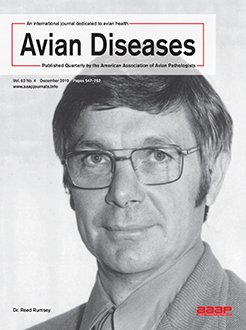Infectious bursal disease (IBD) virus (IBDV) is the causative agent of a highly contagious and immunosuppressive disease of chickens with huge economic losses to the poultry industry despite extensive vaccination. Analysis of isolated IBDV field strains from vaccinated birds would greatly improve the current immunization regimens and support the development of vaccines that offer better immunity. The study investigated the genetic characteristics and pathologic features of IBDVs in commercial broiler chicken farms, as well as the effect of IBDV infection on the efficacy of vaccination against avian influenza virus (AIV) and Newcastle disease virus (NDV) under field conditions. A preliminary diagnosis of IBD was made on the basis of the flock history and the characteristic gross pathologic findings. Microscopically, lymphoid depletion in bursal follicles with infiltration of lymphomononuclear cells along with cystic cavitations reflected the IBDV infection. The molecular analysis confirmed the IBDV infection in (57.1%) of tested flocks. Upon phylogenetic analysis of the VP2 hypervariable region of 14 Egyptian IBDVs, most viruses (n = 12) were clustered within the genogroup 3, while two viruses were closely related to attenuated vaccine isolates in genogroup 1. The analysis of the amino acid (aa) sequences revealed that most of the strains possessed five consistent aas at the VP2 protein (222A, 242I, 256I, 294I, and 299S), which are characteristic for the very virulent IBDV (vvIBDV). Serology indicated the immunosuppressive effect of IBDV, which is represented by a decrease (1.6–2.6 and 1.4–2.6 mean log 2) in the hemagglutination inhibition titer of the low pathogenic AIV subtype H9N2 and NDV, respectively. The examined IBDVs showed a high mutation rate within the hypervariable domain of the VP2 peptide. The results highlighted the need for carrying out an inclusive surveillance of IBDV infections in chicken flocks in Egypt.
How to translate text using browser tools
19 July 2019
Infectious Bursal Disease Virus: Molecular Epidemiologic Perspectives and Impact on Vaccine Efficacy Against Avian Influenza and Newcastle Disease Viruses
Tamer A. El-Aried,
Shimaa M. G. Mansour,
Reham M. ElBakrey,
Abd El-Shakour N. Ismail,
Amal A. M. Eid
ACCESS THE FULL ARTICLE

Avian Diseases
Vol. 63 • No. 4
December 2019
Vol. 63 • No. 4
December 2019
broiler chickens
Egypt
phylogenetic analysis
vaccine
vvIBDV




